Recent Posts
The Unseen Enemy: Uncovering Hidden Water Damage With Moisture Inspections
5/25/2023 (Permalink)
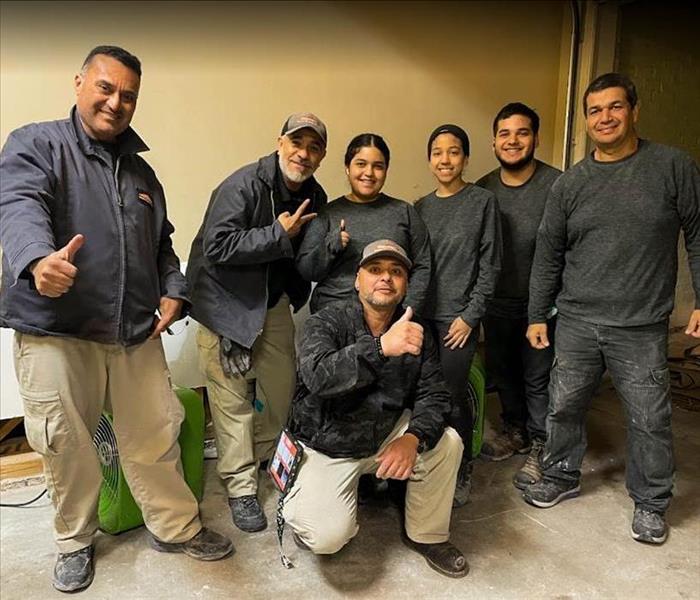 Our SERVPRO water damage restoration technicians are here to help 24/7/365 to help you with your emergency needs. Call today for rapid service!
Our SERVPRO water damage restoration technicians are here to help 24/7/365 to help you with your emergency needs. Call today for rapid service!
When it comes to moisture inspections here in Acworth, many people don't even realize what they're missing. The unseen enemy of water damage can be lurking beneath the surface in any home or business, and only a thorough inspection will reveal its presence. As an expert team in moisture inspections, we’re here to tell you that this hidden menace shouldn't be ignored - if you want to protect your property from costly repairs down the line, uncovering any water issues now is crucial. Moisture inspections are a crucial part of preventing costly water damage repairs and mold.
The signs of water damage aren't always obvious; without proper monitoring equipment, most homeowners won't know there's a problem until water damage restoration is necessary. That is why home maintenance is the ideal first defense.
No matter how big or small your property may be, it pays to keep an eye out for possible signs of water damage. By understanding what needs to be looked for during a moisture inspection and taking proactive steps towards preventing future problems, you'll have peace of mind knowing that your space is safe and secure - all with just one inspection!
What Is A Moisture Inspection And Why Is It Crucial?
A moisture inspection is a comprehensive assessment of the condition and health of any given space. It allows us to detect hidden water damage that can be difficult for the naked eye to see, such as mold or rot. Moisture inspections are important because they provide an accurate picture of what's happening inside the walls and floors. This gives you peace of mind knowing that your home or business is safe and free from potential problems down the line.
What makes moisture inspections so effective is their ability to detect invisible signs that something isn't right - especially when it comes to water-related issues. With advanced technology like infrared cameras and moisture meters, we're able to spot even the most subtle changes in humidity levels before major damage occurs. By pinpointing these issues quickly, we can help prevent further destruction from occurring by taking corrective action sooner rather than later. Knowing this information helps protect not only your property but also those who live or work in it. Now let’s look at how this technology works to uncover the unseen enemy: detecting the invisible with moisture inspections.
Detecting The Invisible: The Technology Behind Moisture Inspections
Moisture inspections are critical to uncovering hidden water damage in any home. To detect the unseen enemy, moisture inspectors like our SERVPRO of Northwest Cobb County team use a variety of technologies that allow them to identify areas of potential concern. These tools include infrared cameras, thermal imaging devices, and hygrometers which measure relative humidity levels.
Infrared cameras can be used to visually inspect walls for temperature differences. If there is an area where temperatures are different from others, it could indicate that moisture has been retained within the wall- or ceiling cavity due to inadequate ventilation, blocked drainage lines, plumbing leaks or other causes. Thermal imaging also identifies hot or cold spots where wet insulation or damp wood framing are present. Hygrometers provide quantitative data on the percentage of moisture present in a particular area allowing us to determine if further investigation is necessary. With these powerful tools at our disposal, we can quickly locate and diagnose sources of hidden moisture and recommend solutions before serious damage occurs.
Common Areas For Hidden Moisture In Your Home
Understanding where to look for hidden water damage is a crucial part of conducting any moisture inspection. Common locations include behind walls, ceilings, cabinets and floors. Moisture can also be found in areas that are difficult to inspect such as attics or crawl spaces. Here are some common areas to look out for during a moisture inspection:
Roofs and Attic Spaces: Look for signs of leaks around the roofline and check ventilation systems for proper functioning.
Walls and Ceilings: Check any cracks or gaps between wallboard/drywall joints or other building materials. Also inspect window frames and door frames for condensation buildup.
Plumbing Fixtures: Inspect around sinks, tubs, showers, toilets and pipes for signs of moisture build up or leaking water.
Basements & Crawl Spaces: Inspect these areas carefully since they are prone to high humidity levels due to their proximity to the ground level.
Flooring: Whether carpet, laminate, or wood, flooring can experience moisture build up causing discoloration, warping, and even harboring mold.
Windows: Because window sealant and window systems can deteriorate over time, sometimes moisture will build up from rain or water sprinklers nearby creating an environment for mold.
Knowing what to look for when inspecting various parts of your home will help you identify potential sources of hidden water damage before it becomes an issue. By understanding the link between hidden water damage and mold growth, homeowners can take proactive measures to prevent costly repairs down the road.
Getting Professional Help: Choosing A Certified Water Damage Restoration Company
When it comes to uncovering hidden water damage and dealing with moisture inspection results, it's important to enlist the help of a professional. Certified restoration companies like ours, are trained in the latest techniques for assessing and mitigating water damage, ensuring that not only is your property restored quickly but also safely.
The first step when selecting a certified company is making sure they are reputable by checking their qualifications, certifications, references, and insurance coverage. It's also important to find out what services they offer; many companies specialize in specific areas such as mold remediation or structural drying. Additionally, make sure you understand how long the process will take from start to finish, so you can plan accordingly. Taking these steps will ensure that you get the best possible outcome from your moisture inspection experience.
Finding a qualified professional does require some research on your part, but it pays off in the end by providing peace of mind knowing that your home or business has been properly repaired and protected against future water-related issues.
Conclusion
The unseen enemy of water damage can be devastating to your home or business. That's why it is so important to get a moisture inspection as soon as possible if you think water damage may be present. With the proper technology, our certified professionals serving Cobb County can detect hidden water damage before it leads to costly repairs or dangerous mold growth.
At our company, we understand the importance of preventing further destruction from happening in your home. We use advanced tools for inspecting any signs of potential water problems that may exist on your property. Our team of certified experts are highly experienced with finding even the most minuscule amounts of moisture in hard-to-reach areas.
Whether you're dealing with visible or invisible water damage, getting a professional moisture inspection done is an essential step toward safeguarding your home and family from long-term issues due to water damage. Don't wait until it's too late - contact us today!
Choosing The Right Fire Damage Restoration Company: What To Look For In A Trusted Partner
3/31/2023 (Permalink)
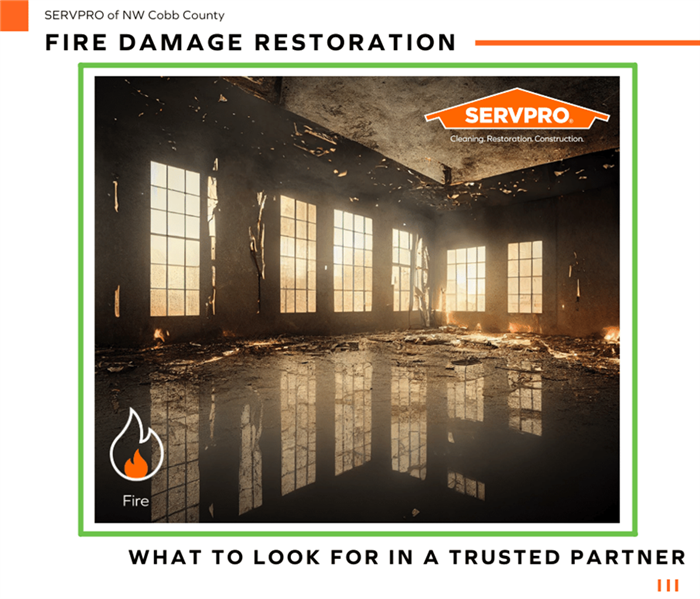 Whether you live in Acworth, Lost Mountain or anywhere in between, our SERVPRO of Northwest Cobb County restoration team is ready to serve you.
Whether you live in Acworth, Lost Mountain or anywhere in between, our SERVPRO of Northwest Cobb County restoration team is ready to serve you.
When it comes to restoring your home or business after a fire, you don't want to leave anything to chance. Choosing the right fire damage restoration company is essential for ensuring that all of the necessary steps are taken in order to get your property back into pre-fire condition. But how do you know which one is best? In this article, we'll explore what you should be looking for when selecting a trusted partner for restoring your building from fire damage.
From the very first phone call through completion of the project, there are several key factors to keep an eye out for when deciding on a fire damage restoration company. First and foremost, they must have extensive experience with working with insurers and other stakeholders involved in the process--this will save time and money by streamlining communication throughout the duration of the job. Additionally, their staff needs to be certified and trained in industry standard practices; this ensures that no corners are cut during any phase of the work.
Also, check references! Reading reviews from past clients can give insight into not only quality assurance but also customer service proficiency. Experienced professionals understand just how traumatic such an event can be; making sure that everyone affected by it receives adequate attention should always be at the top of their list. By following these simple guidelines, you can rest assured knowing that you've chosen a reliable team to restore your property back to its original state as quickly as possible.
Comprehensive Services: Meeting All Your Fire Damage Restoration Needs
When it comes to fire damage restoration, you want a reliable partner who can handle all aspects of the job. Look for one that offers comprehensive services – from smoke and soot removal to odor elimination and water damage repairs. This type of company should have experience in dealing with all types of fires, from small kitchen or bedroom blazes to large-scale disasters. They should also be well equipped to deal with any structural damages caused by the flames or smoke. Finally, they must possess the expertise needed to restore your home or business back to its pre-fire condition.
The most important part when selecting a fire damage restoration service provider is ensuring their technicians are certified and qualified. Ask if they have certifications such as IICRC (Institute Of Inspection Cleaning And Restoration Certification) or RIA (Restoration Industry Association). These qualifications guarantee that the team will know how best to tackle issues associated with fire and smoke damage, like soot removal, deodorizing, mold remediation, and more. Asking about their track record on successful restorations can help you determine whether they’re worth your time and money.
When it comes to choosing the right fire damage restoration company, you want to be sure they have all of the necessary services in order to meet your needs. Look for a partner who can provide comprehensive services like smoke and soot removal, water extraction, mold remediation, structural repairs, and more. This will ensure that every aspect of your home is taken care of properly.
You also want to make sure that any potential partner has experience with complex jobs such as yours. Ask them questions about their past projects and read reviews from previous clients. Communication is key when discussing these details; look for a team that is willing to listen carefully and answer all of your questions thoroughly.
Trust SERVPRO of Northwest Cobb County for Expert Fire Damage Restoration
Dealing with the aftermath of a fire can be an overwhelming and stressful experience. That's why it's essential to choose a trusted partner who can guide you through the process and restore your property to its pre-fire condition. Our SERVPRO of Northwest Cobb County team checks all the boxes that a client could be looking for in a fire damage restoration company. With our experienced and certified team, comprehensive restoration services, and commitment to customer satisfaction, you can rest assured that your property is in good hands.
Don't let fire damage restoration become an additional burden during this challenging time. Give us a call at (770) 966-1442 to discuss your needs and let our skilled professionals take care of the rest. We're here to help you every step of the way, providing the support and expertise you need to restore your home or business to its former glory. Call us today and let us show you why we're the right choice for all your fire damage restoration needs.
Your Guide to Deep-Cleaning Kitchen Appliances: Choosing the Right Products
3/30/2023 (Permalink)
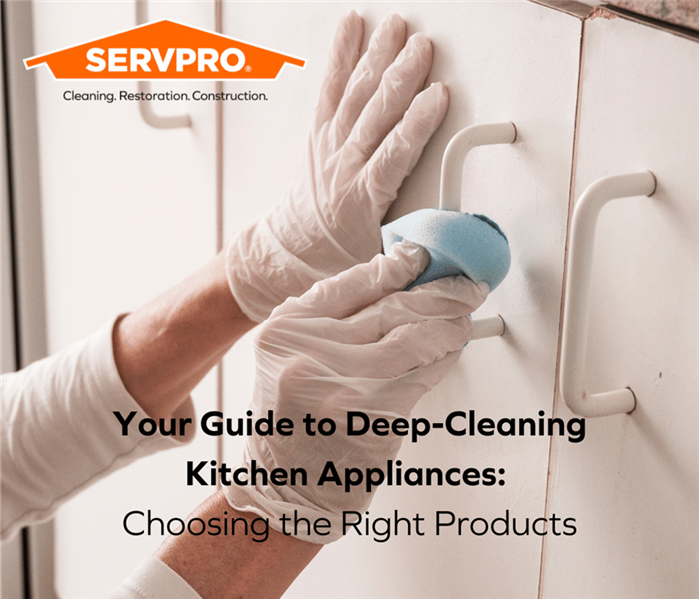 SERVPRO of Northwest Cobb County specializes in commercial restoration services and cleaning here in Acworth and surrounding areas.
SERVPRO of Northwest Cobb County specializes in commercial restoration services and cleaning here in Acworth and surrounding areas.
Maintaining a clean and hygienic kitchen is essential for the health and well-being of your family. Deep-cleaning your kitchen appliances is a vital part of this process, ensuring that every nook and cranny is free of dirt, grime, and bacteria. Our SERVPRO team specializes in commercial restoration and cleaning services, so we know a thing or two about deep cleaning. Knowing what products to use for deep-cleaning kitchen appliances can make the task more manageable and ensure that the job is done effectively. In this blog, we'll discuss the best products for deep-cleaning various kitchen appliances and provide tips for achieving sparkling clean results.
Essential Cleaning Products for Kitchen Appliances
When deep-cleaning your kitchen appliances, there are a few staple products that you should have on hand. These include:
- Dish soap and sponge: Perfect for cleaning surfaces and removing dirt, grime, and food debris.
- Multipurpose or all-purpose cleaner: Useful for thoroughly cleaning various surfaces and appliances.
- Oven cleaner or kitchen degreaser: Designed for tackling tough grease stains and baked-on grime.
- Microfiber cloths: Excellent for wiping down surfaces and appliances, leaving them streak-free.
- Specialty cleaners: Certain appliances, like stainless steel or glass stovetops, may require specific cleaning products to avoid damage.
Deep-Cleaning Techniques for Specific Appliances
Different kitchen appliances may require unique cleaning techniques and products for the best results. Here are some tips for deep-cleaning various appliances:
- Oven and stovetop: Use oven cleaner or kitchen degreaser to remove baked-on grease and grime. For glass stovetops, use a specialized cleaner and a non-abrasive sponge.
- Refrigerator: Remove all food and shelves before cleaning the interior with a multipurpose cleaner or a solution of warm water and dish soap. Wipe down shelves and drawers separately before reassembling.
- Dishwasher: Run an empty cycle with a dishwasher cleaner to remove buildup and mineral deposits. Clean the filter and wipe down the interior surfaces with a damp cloth.
- Microwave: Place a microwave-safe bowl filled with water and a few tablespoons of vinegar inside and heat on high for several minutes. This will help loosen any stuck-on food particles, making it easier to wipe the interior clean with a damp cloth.
Environmentally Friendly Cleaning Options
For those looking to reduce their environmental impact, consider using eco-friendly cleaning products when deep-cleaning kitchen appliances. These products often contain biodegradable, non-toxic, and plant-based ingredients, making them a more sustainable choice.
Conclusion
Deep-cleaning kitchen appliances is a crucial task for maintaining a clean and healthy kitchen. By choosing the right products and following the appropriate techniques, you can ensure that your appliances are thoroughly cleaned and ready for use.
However, if your kitchen has experienced serious fire or smoke damage, SERVPRO of Northwest Cobb County is committed to helping you regain a pristine kitchen environment. Our SERVPRO team specializes in commercial restoration services and cleaning, so if you need assistance or have questions about the right product for your kitchen cleaning, please give us a call!
We’re always here to help.
Your Spring Cleaning Checklist For Property And Vehicles
3/29/2023 (Permalink)
 SERVPRO of Northwest Cobb County is here to help you with all of your commercial restoration and deep cleaning service needs.
SERVPRO of Northwest Cobb County is here to help you with all of your commercial restoration and deep cleaning service needs.
Do you dread spring cleaning? It doesn't have to be a chore! With the right plan, spring cleaning can be a refreshing and rewarding activity. Don't know where to start? We've got you covered with this ultimate spring cleaning checklist for your property and vehicles. Whether you're a neat freak or an occasional duster, this guide will help get your space sparkling in no time. So let's get started!
The first step of any successful spring cleaning endeavor is to make a plan. Break up your list into manageable tasks that you can tackle one at a time. Developing a timeline can also help keep you on track. And don't forget to reward yourself when you finish each task - it'll motivate you to keep going!
When it comes to tackling the nitty-gritty of spring cleaning, it helps to have the right tools on hand. Get out your mops, vacuums, and dusters - and don't forget about all those hard-to-reach places. By stocking up on supplies before diving in, you'll save yourself time and frustration in the long run. Now let's check out our ultimate spring cleaning checklist for home and vehicle!
Preparing For Cleaning
Preparation is key when it comes to spring cleaning, both for your home and vehicle. Before you start the process, take the time to get organized. First, make a list of what needs to be done. This will help keep you on track and ensure that nothing is missed. Second, purchase any necessary supplies or tools and have them ready to go on the day of cleaning. Finally, set aside some time in your schedule for the task at hand. With everything in place, you're now ready to begin!
Dusting And Polishing Furniture
Now that you’re ready to start spring cleaning, it’s time to begin dusting and polishing furniture. Start by wiping away excess dust from all surfaces. Use a microfiber cloth for best results, as it's great at trapping dirt and allergens. To remove tougher dirt and grime, use a wood polish or specialized cleaner designed for the type of furniture you are cleaning. Make sure to follow the manufacturer's instructions for any special care items like leather or glass surfaces.
After dusting, it's time to bring out the polishes and oils! This will help protect your furniture from wear and tear over time. For wood furniture, choose an oil-based wax or polish that won't leave a greasy residue on the surface. If your furniture is made of metal or plastic, try using a non-abrasive cleaner with a soft cloth to buff out scratches and marks.
Finally, don't forget to vacuum upholstered items such as sofas or chairs! Vacuuming can help remove dirt and other particles that can cause damage over time if left on the fabric surface. Keep in mind that some fabrics require special cleaners before vacuuming; check with the manufacturer’s instructions before starting any cleaning process. With these tips in mind, you'll be well on your way to having clean and polished furniture in no time!
Washing Windows And Mirrors
Washing windows and mirrors can be a tedious job, but it's essential to get them clean. Start by dusting off the glass surfaces with a microfiber cloth and an all-purpose cleaner. Be sure to be gentle when wiping the panes, as you don't want to scratch them. Next, use a squeegee and vinegar water solution to scrub away any dirt or grime. Start at the top of the window or mirror and move your way down in quick, even strokes. Wipe up any excess water with a dry cloth afterward.
Once you've done that, it's time to tackle the frames and sills. Start by vacuuming the frame to remove any dust or cobwebs before cleaning it with an all-purpose cleaner and microfiber cloth. For tougher stains, try using baking soda mixed with water for extra cleaning power. Don't forget to check for any signs of mildew or mold in corners as well!
If you’re looking at a lot of cleaning work and prefer to trust a reliable company, SERVPRO of Northwest Cobb County specializes in commercial cleaning and restoration. With our eco-friendly, effective cleaning solutions we’re sure to have the right program for your commercial cleaning needs.
Vacuuming, Mopping, And Carpet Shampooing
Moving on, it's time to tackle vacuuming, mopping and carpet shampooing. Vacuuming is essential to get rid of dust, dirt and other debris that can accumulate over time. Start by vacuuming all carpets, rugs and upholstered furniture. Make sure to use the appropriate attachment for each job; some attachments are designed specifically for stairs or corners. Be sure to empty the vacuum cleaner often so it doesn't lose suction.
Next, move on to mopping hard floor surfaces such as tile, laminate, linoleum and hardwood floors. Start by sweeping up any dirt or debris before mopping. Then use a damp mop with a mild cleaning solution to remove any remaining dirt and grime. For extra shine and protection, finish with a layer of wax or a sealant.
Finally, deep clean carpets with a carpet shampooer or hire a professional carpet cleaner if needed. This will help restore carpets to their original beauty and remove even the toughest stains from pets, kids and everyday wear-and-tear. Plus it will help freshen up your home! To ensure the best results possible, make sure you follow the manufacturer's instructions for the product you're using. With these steps in place your property will be looking spotless in no time!
Organizing Closets And Drawers
Organizing closets and drawers is an important part of spring cleaning. Start by pulling out everything, including clothes, shoes, and accessories. Go through each item, deciding whether to keep it or donate it. If you decide to keep something, make sure to put it in a designated spot. This will help make the most of your space while also making it easier to find items quickly.
Next, use dividers or bins to group items together. For example, separate clothes into categories such as sweaters, shorts, and jeans. This will help you stay organized and save time when you need something quickly. You can also use drawer organizers for smaller items like jewelry and accessories.
After sorting through everything, take some time to clean the closet or dresser itself. Dust off the shelves and vacuum any floor space. Then wipe down the surfaces with a damp cloth or all-purpose cleaner to get rid of any dirt or grime accumulated over time. Doing this will ensure your closets are clean from top to bottom and ready for whatever else you plan on storing there in the future.
Deep-Cleaning Kitchen Appliances
Now that the closets and drawers are organized, it's time to move on to the next task in our spring cleaning checklist: deep-cleaning kitchen appliances. This is an important job that shouldn't be overlooked as it will ensure your appliances are hygienic and running smoothly.
First, begin by unplugging your oven, refrigerator, dishwasher, microwave and other large appliances. Vacuum around them with a handheld vacuum or dustbuster before going any further. You should also make sure to check the coils behind the refrigerator for dust buildup. Then wipe down all the surfaces with warm soapy water and a microfiber cloth or sponge. Be sure to pay extra attention to any areas that contain food residue or spills.
Next, use a degreaser such as vinegar or baking soda paste to remove grease and grime from greasy surfaces like stovetops and backsplashes. Scrub with a sponge or brush if needed. Don't forget to clean the exterior of your appliances too! If you have stainless steel appliances, you may want to use a special cleaner designed specifically for this material in order to avoid leaving streaks on the surface.
Finally, give everything a thorough rinse and dry off any remaining moisture with a soft cloth before plugging them back in again. Taking care of your kitchen appliances regularly will help keep them running efficiently for years to come.
Cleansing Bathroom Fixtures
Cleaning bathroom fixtures can be a chore, but it's essential for keeping your home or business clean and healthy. Start by gathering all the necessary supplies: a bucket, dish soap, cleaning solution, rags or sponges, gloves, and any additional materials needed to complete the job. Start with the sink first; use warm soapy water to remove residue from around the faucet and basin. Use an old toothbrush to get into hard-to-reach areas. Rinse clean before moving on to other fixtures.
Next, focus on the toilet bowl. Put on gloves and apply a cleansing solution to ensure germs are eliminated. Scrub with a brush until all dirt and grime is removed then flush toilet several times. Clean any remaining debris in the tank with a rag and fresh water. Finally, wipe down exterior surfaces of toilet with cleaning solution and a damp cloth – don't forget to disinfect handles!
Once all fixtures are clean, take time to refresh your bathroom by placing fresh towels and flowers in the room. Declutter countertops by organizing items into baskets or drawers; this will help keep things tidy between deep cleans.
Sanitizing Vehicle Interiors
Now that the bathroom fixtures are clean, it's time to move on to sanitizing vehicle interiors. Cleaning and sanitizing your car or company fleet can be a big job, but it's essential for keeping you, your passengers, and employees safe. Start by removing all garbage, wiping down surfaces with disinfectant wipes, and vacuuming the carpets and upholstery. Pay special attention to high-traffic areas such as the steering wheel and gear shift.
Next, make sure to thoroughly clean any fabric surfaces with a foam cleaner or detergent specifically designed for cars. For leather seats, use a mild leather cleaner and conditioner. Finally, use an air freshener or odor eliminator to get rid of any lingering smells.
With some elbow grease and the right cleaning supplies, you can make sure your vehicle is just as sparkling clean as your bathroom fixtures. If you aim to create that new car feel through a thorough cleaning, SERVPRO of Northwest Cobb is here to help as well. With experience cleaning and prepping cars for the dealership showroom, our SERVPRO team is capable of handling any degree of deep cleaning no matter how severe it may be.
Exterior Car Detailing
Detailing the exterior of your car is a great way to give it a brand new look and feel. Start by washing the body of your car with a mild soap solution, making sure to rinse off any excess dirt and debris. After that, get out your clay bar and use it to remove any tough debris or contaminants that have become embedded in the paint. Once that's finished, dry your car completely using a microfiber cloth.
Then, you can move on to waxing and polishing the outside of your car. Apply some wax to the surface of your vehicle to protect it from further damage from weather or debris. You can also use a buffer pad and polishing compound if you want an even shinier finish. Make sure not to apply too much pressure while buffing as this could cause damage to the paint job.
Finally, you can complete the detailing process by applying a coat of sealant to protect your car's exterior even further. Sealants will give a glossy finish while helping keep dirt and dust away from your car's surface for longer periods of time than wax alone would do. And with that, you're all done!
Spring Cleaning Safety Tips
Now that you have completed the exterior car detailing, it is time to move on to spring cleaning safety tips. Before you get started with any of your spring cleaning projects, it is important to take steps to ensure safety for yourself and your family. Here are a few tips to keep in mind:
Make sure all of your cleaning supplies are stored away out of reach of children. Many store-bought cleaning products contain harsh chemicals that need to be handled with caution. So be sure to wear protective gloves and eyewear when using these products, as well as making sure you have good ventilation in the area being cleaned. Additionally, try to avoid mixing different types of chemicals together as this can create hazardous fumes. For example, ammonia and bleach can never be mixed during cleaning because they create harmful gases called chloramines. Chloramines can cause irritation to the lungs, throat, eyes, and nose and in high concentrations can even cause coma or death. That is why precaution when mixing chemicals cannot be emphasized enough.
Also, be careful when working with ladders or other tools that reach high heights. Make sure the ladder is properly set up and stable before stepping onto it, and never stand on the top two rungs. If you need help lifting heavy items on a ladder, ask for assistance from someone else instead of doing it alone. It's also a good idea to always wear slip resistant shoes while cleaning or doing repairs around the house or vehicle.
Finally, be aware of potential hazards while doing spring cleaning like broken glass or exposed wires which could cause injury if not careful. Take breaks throughout the day so that you don't become too fatigued and make sure you stretch before beginning any strenuous activity such as moving furniture or lifting heavy objects. With these safety tips in mind, you can make sure your spring cleaning projects are completed safely and successfully!
Conclusion
As you can see, spring cleaning can be a difficult task. With the right tools and techniques, however, it doesn't have to be daunting. You should take the time to properly clean both your property and vehicle so that they look their best. We suggest using products that are designed for deep-cleaning kitchen appliances, washing windows and mirrors every two weeks, shampooing carpets as needed, following best practices when detailing a car exterior, and taking safety precautions at all times. Doing all these things will help ensure that your home, business and vehicles are looking refreshed and sparkling after a thorough spring cleaning session. So don't put off your spring cleaning any longer - get out there and get started!
And if you would like to know about our commercial cleaning and disinfection services, please give us a call. Our SERVPRO of Northwest Cobb County team is ready to serve you. With our specialized equipment and industrial-grade, eco-friendly cleaning materials and supplies, there is no job too difficult to handle.
Commercial Systems Prone to Water Damage: SERVPRO of Northwest Cobb County
4/28/2022 (Permalink)
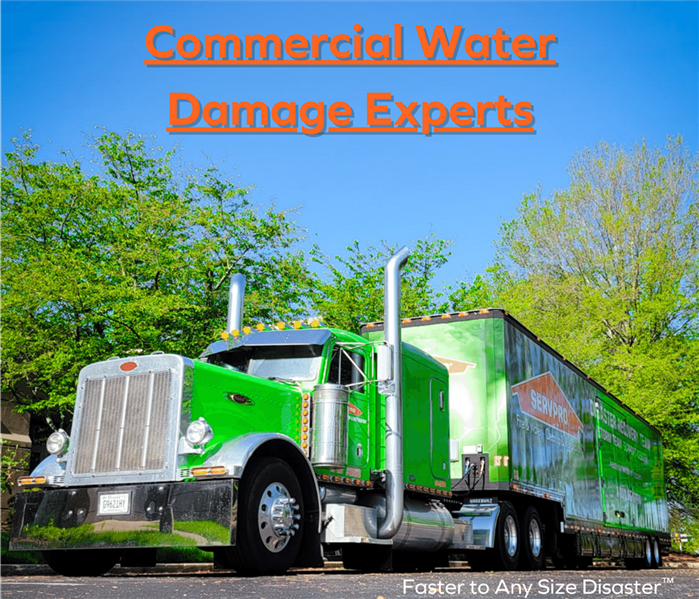 SERVPRO of Northwest Cobb County is ready for whatever happens! We'll restore your business after any size of property damage.
SERVPRO of Northwest Cobb County is ready for whatever happens! We'll restore your business after any size of property damage.
Commercial properties present unique risks when it comes to water damage in Acworth, GA. Unlike residential homes, which are usually one story and have easily accessible crawl spaces and attics, commercial buildings can be many stories high with flat roofs and multiple storefront windows. They also often have expensive specialized equipment that can be very costly to repair or replace if damaged by water. In this blog post, we will discuss the different parts of a commercial building that are at risk for water damage, as well as some tips on how to prevent it.
Plumbing Systems
The first and most obvious risk for water damage in a commercial property is the plumbing system. Because commercial buildings have more bathrooms, kitchens, and other water-using fixtures, they also have larger and more complex plumbing systems. These systems are often located in hard-to-reach places, making them difficult to repair if they spring a leak.
One of the main water damage challenges according to The Hartford Insurance is an improperly maintained sprinkler system. By law, most commercial buildings must have a fire sprinkler system, but many building owners forget to regularly maintain and test these systems. While a well-maintained fire sprinkler system can help prevent extensive fire damage in the event of a fire, improper maintenance or disaster planning can cause extensive water damage that can flood multiple floors.
Another plumbing risk is burst pipes. Commercial buildings, especially high rises tend to run at a higher pressure than residential buildings. Therefore, a burst pipe has the potential to release significantly more water than a home.
One of the ways in which we help commercial property owners prevent catastrophic property damage before it happens is through our app-based Emergency Response Planning program (ERP).
Roofing Systems
In addition to the plumbing system, there are a number of exterior commercial building components that can experience water damage. One of the most common is the flat roof. Because flat roofs are not sloped like traditional pitched roofs, they tend to pool water instead of shedding it. This can lead to leaks and eventually, if left unaddressed, major water damage.
Some common commercial roofing systems include:
- Built-up Roofing (BUR): Often called tar and gravel roofs, these commercial roofing systems are built with a semi-continuous membrane installed in layers, then covered in aggregate. While they are usually simple to maintain, best practices suggest inspecting the roof for deterioration and possible leak points at least twice yearly.
- Thermoplastic Single-Ply Membrane Roofing (PVC & TPO): These roofs are installed in large rolls that are then welded together at the seams with heat. The material is very durable and oil-resistant. However, the heat-welding methods require skilled installation, which can lead to weak points and leak-prone areas if not performed correctly.
- EPDM Roofing: Some roofers call these "rubber roofs" because the material they are made of, ethylene propylene diene monomer is very rubber-like. This kind of roof is derived from oil and natural gas, and appears dark gray or black. When installed correctly and with the highest thickness available, this type of commercial roof will last a very long time with little to no issues. Unless you experience storm damage in your area, an annual check for leaks around the roof penetrations should suffice.
Window Systems
Commercial window systems are built for durability and use, however, they can often present a unique water damage challenge for commercial facilities. Most aluminum glazing systems aren't intended to be 100% waterproof. Most commercial window systems are meant to limit water penetration during extreme circumstances while also weeping water back out to the exterior.
By directing all moisture to the sill flashing, storefront systems limit water penetration. It's critical that the sill flashing be installed correctly in order to avoid water damage. Making sure that sealant is put on the top of the rear leg before installing the sill is one of the most important aspects of a good installation.
The most essential aspect of maintaining water penetration with a storefront is end dam fastening and sealing. Water will enter the building through the jamb locations if end dams are not properly fastened and sealed. Improperly (or missing) end dams can cause significant water damage to the interior drywall or flooring around commercial storefront windows.
Like anything else in a building, time and the elements can cause wear and tear and failure of these commercial window water control systems.
Commercial Water Damage Inspection Services
So if you notice moisture or water damage around your storefront windows, you should consider calling SERVPRO of Northwest Cobb County to inspect for potential water damage issues. Our technicians are trained to identify, troubleshoot, and restore all types of commercial water issues.
Call today to schedule your commercial service!
(770) 966-1442
Tips to Stay Safe during Fire Damage: SERVPRO of Northwest Cobb County
3/29/2022 (Permalink)
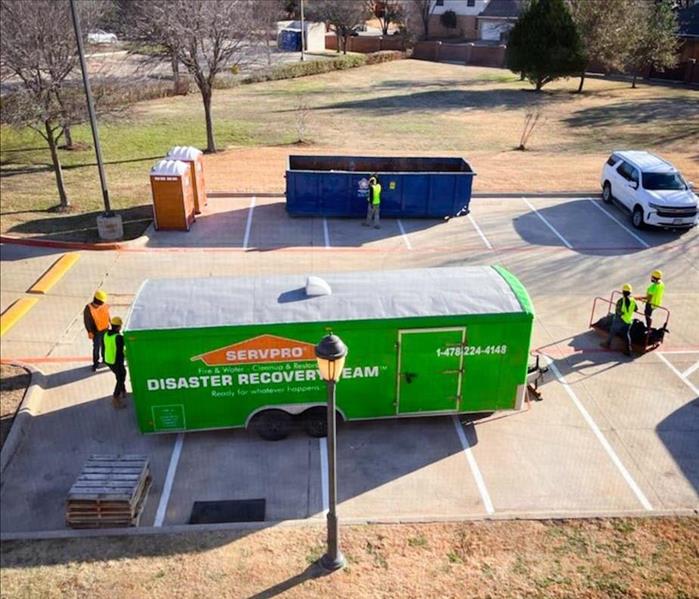 No matter how serious your property damage may be, SERVPRO of Northwest Cobb County is your local expert for restoring your home or business.
No matter how serious your property damage may be, SERVPRO of Northwest Cobb County is your local expert for restoring your home or business.
It's that time of year again - fire season in Acworth, GA, and surrounding areas. Between February and May, the weather gets hotter and drier, while the risk of house fires rises. A fire may start from a variety of sources, ranging from a faulty wire to an overloaded outlet to a kitchen mishap to a bonfire left unattended. It's critical to know how to react quickly and effectively if your home catches fire.
Here's What You Need To Know If A Fire Starts:
The first line of defense against a house fire is to know how to use the proper fire extinguisher for the situation. This simple procedure can help save lives and hundreds of thousands of dollars in property damage. If the fire spreads uncontrollably, evacuate immediately and stay away, then call 9-1-1. Leave all of your belongings where they are and save yourself and your loved ones.
If your clothing ignites, remember the old adage: Stop, Drop, and Roll.
It's critical to utilize the stairs if you live in a building with elevators in case of a fire. The elevator electrical system may be damaged by a fire, causing the shaft to operate like a chimney and rapidly fill up with deadly fumes.
Doors may be used to your advantage in a fire, potentially saving your life. If the doorknob or handle is hot, don't open it. If you can't exit through the primary route, look for another option. Do not open any doors that are warm to the touch.
Close any doors that might obstruct your exits, lay a wet towel beneath the doors, and call the fire department or 9-1-1 if flames, heat, or fire block your avenues of escape. Tell them exactly where you are so they can find you.
If you're near a window that you can't use as an escape, open it and wave a brightly colored cloth or use your phone flashlight to signal for help.
What To Do After a Fire
After a fire, it is important to contact a professional fire damage restoration company like SERVPRO of Northwest Cobb County. We have the training, experience, and equipment to properly restore your home - "Like it never even happened."
If you try to clean up the fire damage yourself, you could end up making the situation worse both in your home and with your insurance company's process.
Trust the experts, and call today!
Georgia and Spring Weather | SERVPRO® of Northwest Cobb County
3/25/2022 (Permalink)
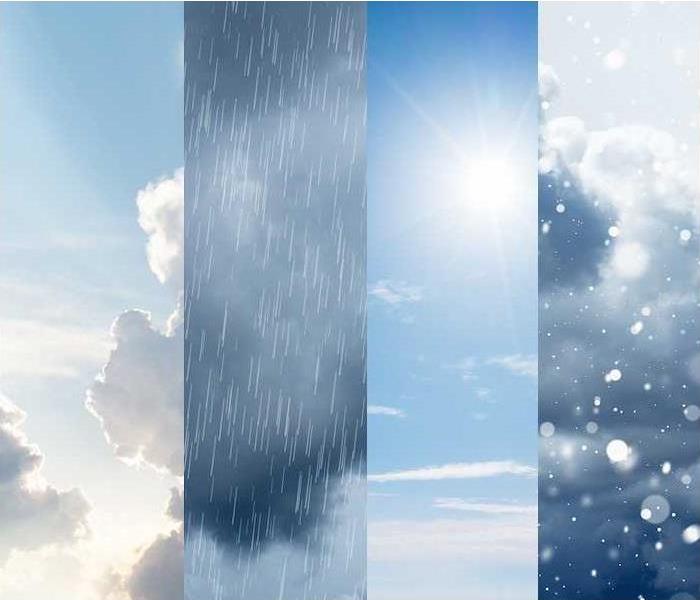 Extreme temperature changes can lead to severe weather. SERVPRO of Northwest Cobb County is a click away if you experience any damage.
Extreme temperature changes can lead to severe weather. SERVPRO of Northwest Cobb County is a click away if you experience any damage.
The United States is one of the world’s largest countries, beaten in total landmass only by Russia, China, and Canada.
Seasonal climate isn't one-size-fits-all in a country with such a huge and varied territory under one roof; different regions of the country experience unique weather patterns, implying they face varying degrees of weather hazards at various times throughout the year.
Different parts of the country have different weather patterns. For example, in the springtime, warm and cold air masses often collide in different parts of the US. Let's take a look at what to expect in some key regions, as well as what we need to be aware of here in Georgia.
The Pacific Northwest is vulnerable to significant rain throughout the spring, which may cause floods and water damage to homes. Snow will continue to fall at higher elevations, with the melting and runoff from that causing additional problems.
The Upper Midwest and Northeast have the longest winters to face as cold weather will stick around for the whole season. Extreme cold and the threat of snowstorms and blizzards may be expected stretching from Maine to the Dakotas until late spring or perhaps early summer, when temperatures begin to rise.
Excessive heat waves will plague the southern West Coast, while the South Pacific, including Hawaii, will be on high alert for tsunamis triggered by tectonic activity..
The Midwest, from Iowa to Texas, will face many weather threats this year. These include wildfires, windstorms, and derechos. When the winds are strong and it is dry outside, wildfires can quickly spread. Of course, Tornado Alley is part of this region, which has a high incidence of tornadoes.
Finally, there is the possibility of extreme weather in the Southeast. This can include tornadoes, powerful thunderstorms, and dangerous rip currents. Georgia is often hit by thunderstorms. In addition, remnants of tropical storms that arrived via coastal states might produce significant flooding on occasion.
No matter where you live in the United States, property damage due to extreme weather is a risk. Your state may have different risks than your friend's state, but it is always a good idea to be prepared.
Help is only a phone call away if your property has been damaged by water, fire, or other elements in extreme weather. For prompt, professional recovery, contact your local SERVPRO of Northwest Cobb County.
6 Simple Maintenance Tips to Keep Your Home Safe From Water Damage | SERVPRO® of Northwest Cobb County
3/22/2022 (Permalink)
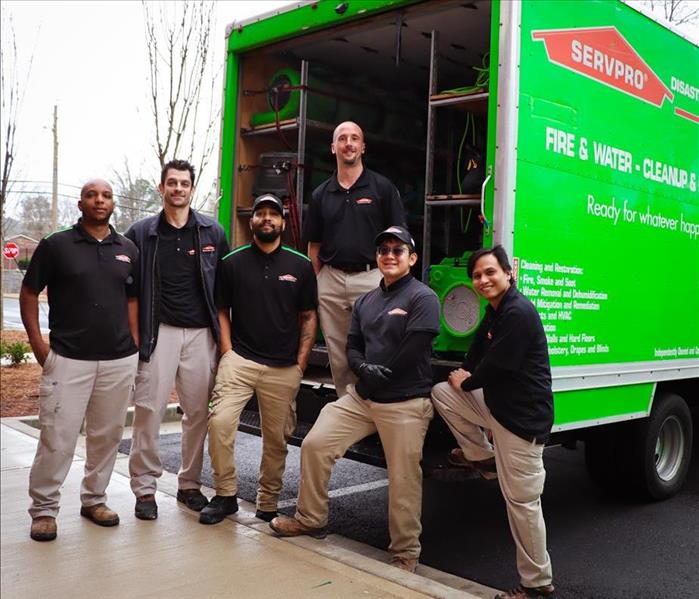 Our trained SERVPRO technicians are ready to support you immediately with all of your water damage restoration needs. Call us today!
Our trained SERVPRO technicians are ready to support you immediately with all of your water damage restoration needs. Call us today!
Water damage is expensive and inconvenient. SERVPRO of Northwest Cobb County, your local water damage expert, has seen this happen many times. If you take care of your property, it will help to prevent water damage and also minimize the cost. If your property floods, it's natural to feel stressed. However, you can help prevent damage and avoid the stress by following these easy maintenance suggestions.
1) Replace old caulk around your windows to avoid dampness and moisture.
We get a lot of inquiries for window caulk related water damage repair in Acworth, Georgia and in nearby areas. Caulking your windows not only prevents water leaks, but it also helps to improve your air conditioner's efficiency while keeping the outside air out of your home. It's a simple operation that any homeowner can complete. Caulking should last roughly five years before needing to be replaced, depending on the type; nevertheless, you should inspect your caulking yearly and replace it if it begins to fracture or come away from the glass.
Exterior door flashings should also be inspected to see whether there are any holes or rust that would allow water in. You can also help prevent early door flashing failure by properly caulking them.
2) Check your water heater for leaks to keep it from flooding and causing water damage.
Water heater failures are all too common when it comes to our emergency water cleanup services. Maintaining your house on a regular basis may help you avoid a major water heater flood. To prevent the formation of pressure, which might lead to a leak, make sure the water heater's thermostat is set to regulate temperature precisely.
Water heaters frequently develop rust or silt inside, resulting in a peculiar taste or odor in the water. If your water begins to make unusual noises, it's probably time for an inspection or a new water heater.
3) Replace any leaking or worn water hoses or connections immediately.
Look for any holes, kinks, fraying, deterioration, or corrosion on your plumbing's hoses and connections. If you detect any damage, get it fixed right away. Most manufacturers and plumbers recommend changing water hoses and connections every three to five years in order to prevent unexpected water damage issues.
(5) Check the roof and gutters for debris and that your attic is free of moisture damage.
The roofing material on your home may deteriorate if rainwater is not draining properly. This can allow water to seep into your house.
Look for dampness around vents, valleys, chimneys, pipes, and skylights. Anyplace on your roof with holes or connections is a potential source of leaks later on. If the flashing deteriorates as a result of weather, rusting, or losing its seal, water may flow into your home.
Examine the interior of your attic for moisture or mold growth. If you find damp, damaged, or moldy insulation, rotten or discolored boards or ceiling panels, or sheetrock puckering, you may have a leak on your hands.
(6) Clean and inspect the HVAC condensation lines to look for any leaks or clogs.
If your HVAC condensation lines become clogged, water leaks out and damages the surrounding areas of your home. Every month, check your condensation lines to ensure they're free of debris.
Pour one-half cup of plain, white vinegar down the condensate drain once to four times a year to clean out blockages and grime. Bleach should not be used since it can damage your metal drain pan and cause it to deteriorate. Our SERVPRO experts can help you with any water damage cleanup if you notice an accumulation of debris or mold.
We are Here to Assist You with All of Your Water Repair Needs
Contact our team at SERVPRO of Northwest Cobb County if you or someone you know requires water damage repair services.
Our friendly, trained staff are always ready to answer any and all of your questions. Save our phone number for when you need assistance in the future, or contact us right now for a quick response from one of our IICRC-trained water restoration specialists.
We are always Here to Help!
How To Protect Your Property From Cigarette Fires
2/26/2022 (Permalink)
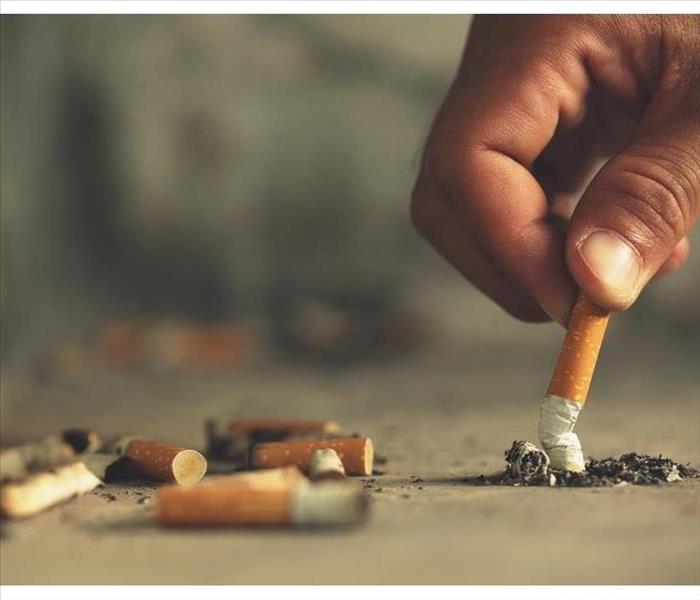 Cigarettes continue to cause a high number of house fires each year.
Cigarettes continue to cause a high number of house fires each year.
How To Keep Your Home Safe From Cigarette Fire
Cigarettes continue to cause a high number of house fires each year, even though the number of smokers has dropped dramatically. Here are five easy ways to keep your property and loved ones safe from a cigarette fire.
1. Keep Lighters Away From Children
Kids, especially very young ones, may be completely unaware of the dangers of playing with fire. Make sure that cigarettes, lighters and matches are stored out of reach of children. Educate youth about fire safety.
2. Don’t Allow Smoking Indoors
Many objects and items in your home are highly flammable, including books, upholstery, curtains and carpets. To avoid the risk of starting a blaze from a spark due to a lit cigarette or hot ashes, make it a rule that smoking must be done outside of the house.
3. Never Smoke When Tired
If you smoke when you’re drowsy, you put yourself at risk of falling asleep and starting a cigarette fire. Even if you don’t feel sleepy, do not smoke while reclining or lounging to reduce the chances of dozing off with a lit cigarette in your hand. Always avoid smoking in bed.
4. Use Proper Ashtrays
Remember to use sturdy ashtrays when smoking, and fill them with sand if possible. Douse ashes and cigarette butts with water before emptying them into the trashcan to reduce the chances of an ashtray fire. Never extinguish cigarettes in vegetation, such as grass or leaves that could be dry and may present a fire hazard.
5. Avoid Smoking Near Medical Oxygen
Oxygen tanks are extremely flammable, and smoking around them could cause them to combust. Likewise, avoid lighting up around any chemical that may start a blaze.
Taking these precautions can keep your home in Kennesaw, GA, safe from a dangerous cigarette fire. If you need assistance or have questions about fire cleanup, reach out to a fire restoration company for help.
5 Ways SERVPRO Serves You Best
2/19/2022 (Permalink)
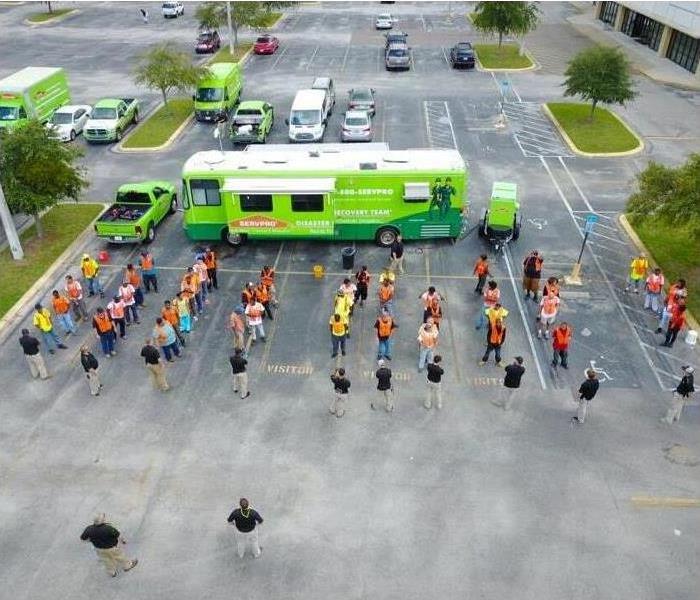 The leading restoration company in Acworth, GA.
The leading restoration company in Acworth, GA.
5 Ways SERVPRO Can Help You
Assessing a claim from a client can be a complicated process. You don’t need the vendor that performs the restoration to throw a proverbial wrench in the mix. If you are an insurance adjuster in Acworth, GA, SERVPRO is provided up-to-date information and keeps costs as low as possible.
1. Nationwide Support
While your client may just be working with the local franchise, you have the backing of the company’s national resources. These include:
- Call center
- Standardized quality requirements
- Exemplary record-keeping
2. Commitment to Restoration
While many remediation companies may default to tearing out and replacing materials, most insurance companies want to work with certified restoration experts who seek first to restore the existing structure and materials. Each item is tested to see if it’s salvageable to cut down on costs.
3. Accessible Records
As the insurance adjuster assigned to a case, you have access to the Claims Information Center. This is a record of all the documentation associated with your client’s claim, including photos of the damage, response time a detailed estimate of the final cost of repairs.
4. Immaculate Itemization
In addition to online records, you receive an itemized list of everything that needs to be replaced. This information is crucial to assessing the insurance claim made by your client.
5. Professional Service
SERVPRO technicians complete an IICRC-certified training program. As methods improve in the industry, they participate in ongoing education to ensure that they provide the highest standard of mitigation services. You can depend on your local franchise to respond quickly to your client’s call and start repairs in a timely manner. This minimizes the damage and, ultimately, your final cost.
An insurance adjuster is often the first person to assess the damage to a client’s home. The professional knowledge and experience of qualified restoration specialists can prove to be invaluable resources during this process. When it comes to assessing your client’s claim, SERVPRO is Here to Help.





 24/7 Emergency Service
24/7 Emergency Service







